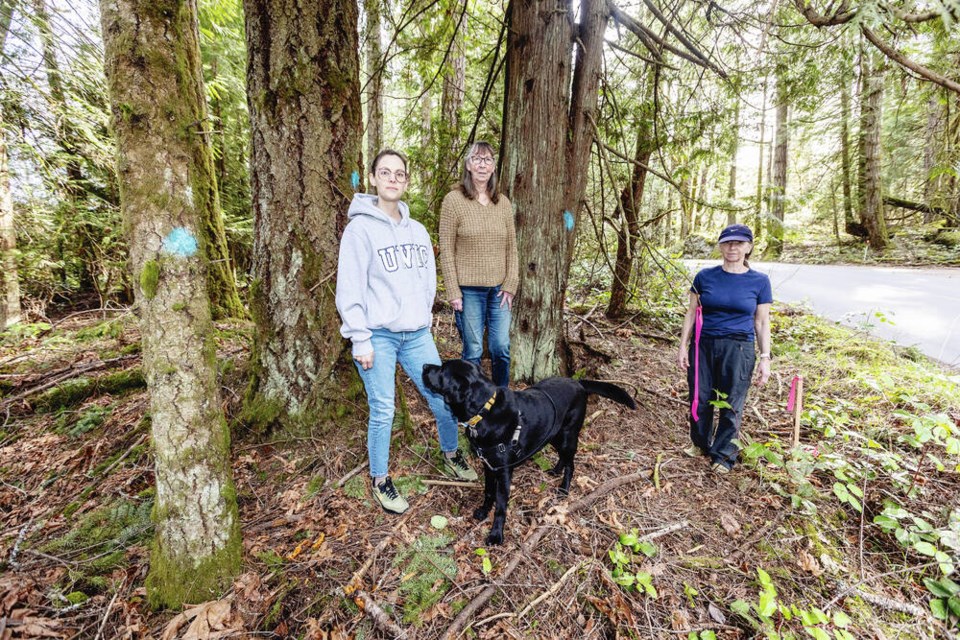The District of Saanich and residents of the Prospect Lake neighbourhood are asking B.C. Hydro to reconsider a plan to upgrade power lines in the area that could result in the removal of 362 trees.
The project, which has yet to be fully designed and budgeted, would upgrade the high-voltage power lines along Prospect Lake Road from Meadowbrook Road to Munns Road.
A group of area residents says B.C. Hydro appears to be ignoring climate concerns and solely focused on delivering power.
“We haven’t been privy to any information that shows justification for a project that would have such a negative environmental impact,” said resident Joan Hendrick. “We’re in a climate crisis and we have an organization that currently operates outside of those concerns, it seems. There’s been no indication of any mitigation steps that could be taken.”
Hendrick said the group has been asking that B.C. Hydro take another look at the project given it is to happen in the sensitive ecosystem of the Tod Creek Watershed.
The group also suggests there’s little need for an upgrade as the area is zoned for lot sizes of no less than 10 acres, and there are no known plans for subdivisions.
“We’re seeing a lot of development outside of rural Saanich that’s resulting in an awful lot of trees being cut down,” Hendrick said, noting the heavily treed Prospect Lake area is a key part of rural Saanich. “It’s a prime nesting area and this would be a huge loss of trees. Our concern is that with climate change, we’re already seeing all our western red cedars dying and now the Douglas fir are under immense stress. None of that’s projected to get better.”
The district appears to be backing the residents.
Monday night, Saanich council agreed to have Mayor Dean Murdock write a letter to B.C. Hydro requesting the utility look at alternatives that would minimize the removal of trees and that B.C. Hydro follow the tree-replacement provisions in Saanich’s bylaws.
If this were a municipal or private project in the district, it would be required at a 3:1 replacement ratio. A goal of Saanich’s urban forest strategy is a minimum of a 1:1 replacement ratio for all tree removals.
Coun. Nathalie Chambers said she was shocked when she saw how many trees were at risk.
“It really struck me how powerless we feel when there is another corporation operating on our lands,” she said.
Because B.C. Hydro is governed by the Hydro and Power Authority Act, which supersedes municipal bylaws, it is not subject to Saanich’s tree-protection bylaws that require developers to replace trees removed for new projects.
Saanich’s parks department has been in contact with B.C. Hydro and suggested ways of reducing the impact on trees by exploring alternative designs and construction techniques.
B.C. Hydro spokesman Ted Olynyk said because the project has not yet been designed it’s not clear how many trees will be affected by being removed or trimmed so they don’t pose a hazard to the lines.
He said he completely understands the concern of residents, but the pressure is on B.C. Hydro to ensure it can deliver reliable power. “We do everything we can to minimize the impact of our infrastructure and we will work with the community to do that. But this is being done because of growth in the area. We have growth and we have to meet that load.”
Olynyk said the single power line that serves the area now is not adequate to keep up with the demand of more people living in the area and the fact more things, such as cars, are running on electricity.
The single line, much of which is on private property, will be replaced with what B.C. Hydro calls three-phase line, which can carry a higher load, on the municipality’s land.
Olynyk said there are number of reasons the new line cannot simply go where the existing one does, not the least of which being it would require right-of-way agreements with every property owner along the route.
“Irrespective of that, because you are increasing the line, you’d still have to increase the clearance around the line, no matter the route,” he said. “You’re still going to need vegetation management to get the clearance you need.”
Olynyk said B.C. Hydro has a greening program that provides funds to communities to replant in an area as long as the plants don’t conflict with power lines.
The project is scheduled to start after nesting season in the fall.
aduffy@timescolonist.com
>>> To comment on this article, write a letter to the editor: letters@timescolonist.com



